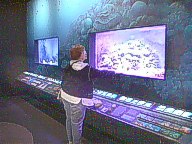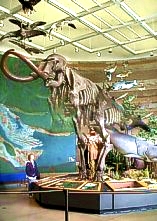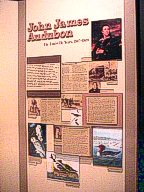The Falls of the Ohio
An Indiana State Park
Jeffersonville, IN
March 12, 2000
I was  sitting around a campfire, as I often do, with
several other local campers discussing the area in and around
Louisville, Ky., when one old-timer remarked that if it weren't for
the Falls of the Ohio river, this area would probably be just
another meandering stretch of river. Waterfalls in the Ohio
River? Now that was a new one on me. I had lived in Cincinnati on
the river for several decades and had always assumed that there
were no obstructions to the river system between Pennsylvania and
New Orleans. The next day we set off to find these little-known
falls. Our travels took us to the Falls of the Ohio State Park in
Jeffersonville, IN. An Interpretive center sits on the bank of
the river and tells the story of thousands of years along the
river, and yes, right out in front of us, unfortunately under
several feet of water as the Ohio was running quite high that
day, are a ragged series of rocks and boulders which, during low
water
sitting around a campfire, as I often do, with
several other local campers discussing the area in and around
Louisville, Ky., when one old-timer remarked that if it weren't for
the Falls of the Ohio river, this area would probably be just
another meandering stretch of river. Waterfalls in the Ohio
River? Now that was a new one on me. I had lived in Cincinnati on
the river for several decades and had always assumed that there
were no obstructions to the river system between Pennsylvania and
New Orleans. The next day we set off to find these little-known
falls. Our travels took us to the Falls of the Ohio State Park in
Jeffersonville, IN. An Interpretive center sits on the bank of
the river and tells the story of thousands of years along the
river, and yes, right out in front of us, unfortunately under
several feet of water as the Ohio was running quite high that
day, are a ragged series of rocks and boulders which, during low
water cause a cascading sheet of water to rush over them, creating the
effect of a small but violent waterfall. Navigation through this
barricade has always been non-existent. Surprise, surprise, but
there is more. Ancient history abounds here, I mean really
ancient history. Before the coming of the ice age, this entire
area was one vast tropical inland sea,
cause a cascading sheet of water to rush over them, creating the
effect of a small but violent waterfall. Navigation through this
barricade has always been non-existent. Surprise, surprise, but
there is more. Ancient history abounds here, I mean really
ancient history. Before the coming of the ice age, this entire
area was one vast tropical inland sea,  filled to the brim with all kinds of sea life,
especially a large assortment of shell fish. Thousands of years
of existence created a thick sea bed of limestone with millions
of these sea creatures embedded as fossils in the forming rock.
The last Great Ice Age saw the glaciers reach right up to the
land making up the Ohio River. Runoff from the receding ice
created the Ohio Valley by literally ripping up the ground and
rocks with sheer water pressure. What was left was a gigantic
gouge in the limestone bottom of the once tranquil sea,
exposing the fossils for all to see. The park is now one
filled to the brim with all kinds of sea life,
especially a large assortment of shell fish. Thousands of years
of existence created a thick sea bed of limestone with millions
of these sea creatures embedded as fossils in the forming rock.
The last Great Ice Age saw the glaciers reach right up to the
land making up the Ohio River. Runoff from the receding ice
created the Ohio Valley by literally ripping up the ground and
rocks with sheer water pressure. What was left was a gigantic
gouge in the limestone bottom of the once tranquil sea,
exposing the fossils for all to see. The park is now one  of
the greatest archeological dig areas in the nation, as is
indicated by the skeleton of a great woolly mammoth standing just
inside the front door of the interpretive center. Each room of
the center covers a different time period for the Falls. If I
thought that finding falls on the Ohio was going to shake my
understanding of the area I been living in, I was soundly shocked
to find that the very heart of history of this country was being
challenged. It would seem plausible that perhaps Christopher
Columbus was not the first European to discover the "New
World". According to legend, the first white settlers at the
Falls of Ohio may have been Welshmen in the year 1170 A.D. This
story places European settlers in America over 300 years before
Christopher Columbus sailed to the new world. Historical records
indicate that in 1167 A.D. Madoc, one of the 17 sons of Owen Gwyneth, Prince of Wales, set sail to explore the western seas.
of
the greatest archeological dig areas in the nation, as is
indicated by the skeleton of a great woolly mammoth standing just
inside the front door of the interpretive center. Each room of
the center covers a different time period for the Falls. If I
thought that finding falls on the Ohio was going to shake my
understanding of the area I been living in, I was soundly shocked
to find that the very heart of history of this country was being
challenged. It would seem plausible that perhaps Christopher
Columbus was not the first European to discover the "New
World". According to legend, the first white settlers at the
Falls of Ohio may have been Welshmen in the year 1170 A.D. This
story places European settlers in America over 300 years before
Christopher Columbus sailed to the new world. Historical records
indicate that in 1167 A.D. Madoc, one of the 17 sons of Owen Gwyneth, Prince of Wales, set sail to explore the western seas.  Their
expedition led them to a promising new land. Madoc later returned
to Wales to gather people who would join him in establishing a
colony in this new land. Madoc, his followers and as many as ten
ships with supplies sailed west, never to return. It is thought
that the colonists sailed along the North American coast to the
Gulf of Mexico. There they entered Mobile Bay in Alabama and made
their way across to the Mississippi River
Their
expedition led them to a promising new land. Madoc later returned
to Wales to gather people who would join him in establishing a
colony in this new land. Madoc, his followers and as many as ten
ships with supplies sailed west, never to return. It is thought
that the colonists sailed along the North American coast to the
Gulf of Mexico. There they entered Mobile Bay in Alabama and made
their way across to the Mississippi River  and then up the Ohio River to the Falls of Ohio.
Early European and American explorers related stories of Welch
speaking Indians living near the Falls. General George Rogers
Clark, the older brother of William Clark of the Louis and Clark
Expeditions into the Louisiana Purchase lands, was told by a son
of Chief Tobacco of the Shawnee Indians that long ago many white
men had been killed in a great battle at the Falls. Actually, it
was General George Rogers Clark who founded Clarksville on a
thousand acres of the 150,000 acre tract the Virginia Assembly
granted him and his troops in recognition of General Clarks'
efforts in the Revolutionary War. The town was chartered in
1783, and General Clark
and then up the Ohio River to the Falls of Ohio.
Early European and American explorers related stories of Welch
speaking Indians living near the Falls. General George Rogers
Clark, the older brother of William Clark of the Louis and Clark
Expeditions into the Louisiana Purchase lands, was told by a son
of Chief Tobacco of the Shawnee Indians that long ago many white
men had been killed in a great battle at the Falls. Actually, it
was General George Rogers Clark who founded Clarksville on a
thousand acres of the 150,000 acre tract the Virginia Assembly
granted him and his troops in recognition of General Clarks'
efforts in the Revolutionary War. The town was chartered in
1783, and General Clark  built a home there in 1803, the only home he
ever owned. From it, on a site overlooking the Ohio, he could see
Louisville, which he also founded. From there, he wrote frequent
letters to the United States government seeking reimbursement of
the sums he had personally advanced to pay and supply
Revolutionary War troops. The famous Lewis and Clark expedition
sought men and supplies in Clarksville and in other towns at the
Falls before starting the journey westward in 1803 to explore the
Louisiana Purchase. Early in the history of commercial travel on
the Ohio, a channel was built on the Kentucky side which serves
today as a gateway around the falls. It was all a surprise to me.
built a home there in 1803, the only home he
ever owned. From it, on a site overlooking the Ohio, he could see
Louisville, which he also founded. From there, he wrote frequent
letters to the United States government seeking reimbursement of
the sums he had personally advanced to pay and supply
Revolutionary War troops. The famous Lewis and Clark expedition
sought men and supplies in Clarksville and in other towns at the
Falls before starting the journey westward in 1803 to explore the
Louisiana Purchase. Early in the history of commercial travel on
the Ohio, a channel was built on the Kentucky side which serves
today as a gateway around the falls. It was all a surprise to me.
*** THE END ***
